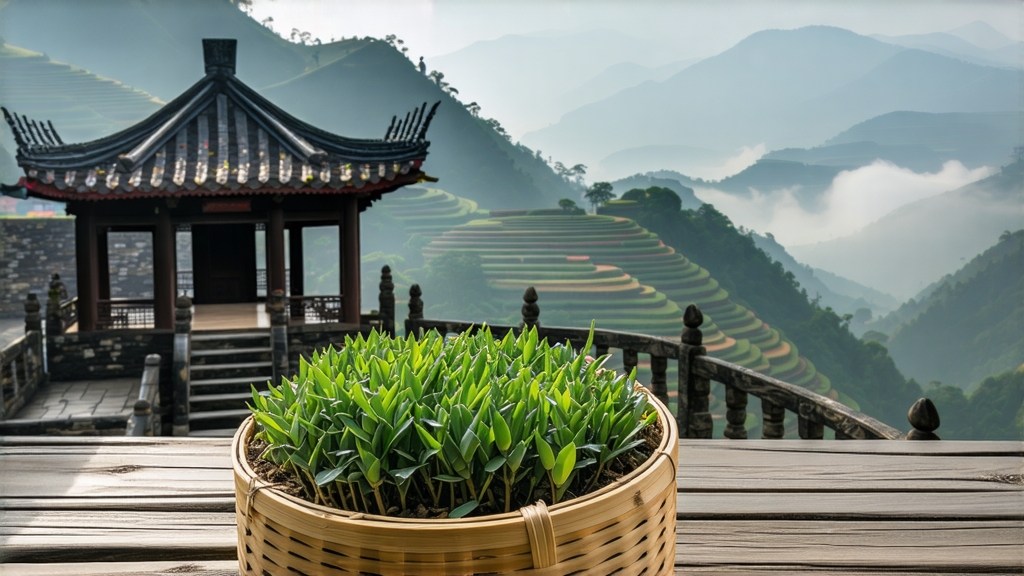
Tucked high on the mist-locked Meng Ding Mountain in Sichuan Province, Meng Ding Huang Ya has been whispered about in Chinese tea texts since the Tang dynasty (618-907). Court chroniclers record that it reached the imperial table as early as 724 CE, when governor-master Zhang Shouzhen presented the “first spring buds” to Emperor Xuanzong. For the next twelve centuries the tea remained a coveted tribute, shipped down the Min River in sealed bamboo tubes lined with camphor leaves to keep its signature yellow-green luster. Foreign merchants first encountered it in the late Ming through the “Tea-Horse Road,” but its tiny annual yield—often less than 300 kg—kept it virtually unknown outside the palace and the monasteries that crowned the mountain.
Meng Ding Huang Ya belongs to the yellow tea family, a micro-category that sits genetically between green and lightly oxidized oolong. What distinguishes yellow teas is the “sealing yellow” or men huang step: after the leaf is fired it is wrapped while still warm in thick paper or cloth, then left to breathe in low-temperature humidity for several hours. The process oxidizes a minute portion of catechins, softening grassy edges and coaxing a mellow, chestnut-sweet liquor the Chinese describe as “ripe grain in morning sun.” Among the six officially recognized yellow teas, Meng Ding Huang Ya is the only one made exclusively from the unopened bud, making it the most delicate and labor-intensive.
Plucking begins in the fleeting “before Qingming” window, usually ten days around late March when night temperatures hover at 10 °C and mountain fog slows photosynthesis, concentrating amino acids. Only the “sparrow’s tongue” bud—an unopened tip flanked by two miniature cataphylls—is taken. Experienced pickers work barefoot on 60-degree slopes, laying the buds into shallow bamboo sieves to prevent compression. Within two hours the harvest is carried to the monastery-turned-factory at 1,450 m elevation where three master craftspeople handle every gram through five meticulous stages:
- Sha Qing (kill-green) over lychee-wood charcoal, 140 °C for four minutes, hand-tossed in a 90 cm wok to denature polyphenol oxidase without scorching the downy hairs.
- Re Xiang (hot rolling) while the bud is still 60 °C, coiling it into a tight fish-hook shape that will later unfurl like a miniature fern.
- Men Huang (sealing yellow) in three cycles: wrapped in steamed hemp paper for 50 minutes, unwrapped to breathe for 10 minutes, re-wrapped twice more. Relative humidity is kept at 78 % using mountain spring water trays; temperature is never allowed above 32 °C.
- Mao Huo (low baking) on bamboo trays 40 cm above charcoal embers, 60 °C for two hours, reducing leaf moisture to 20 %.
- Zu Huo (foot-firing) the next dawn: buds are placed in a paper-lined iron pan and walked upon with cotton socks. The dancer-like motion, passed down by monks, compresses the bud tip yet preserves its down, locking in the golden color that gives the tea its name.
The finished leaf resembles a tiny golden spearhead, 12–15 mm long, covered in microscopic “silver down” that feels like peach fuzz. When brewed it exudes aromas of fresh lychee, steamed edamame and a trace of sandalwood incense once used in the monastery.
Water is the invisible ingredient. Meng Ding’s springs percolate through Jurassic sandstone, emerging with a neutral pH of 7.1 and a dissolved-solids count below 80 ppm—ideal for highlighting the bud’s natural theanine. For western palates I recommend 3 g of leaf (roughly 40 buds) in a 150 ml tulip-shaped glass. Heat water to 80 °C, pour along the wall to avoid scalding the hairs, then cover and steep 90 seconds. The first infusion yields a pale chardonnay liquor with a “ring of gold” at the meniscus. Inhale deeply: top notes are orchid and rain-soaked bamboo; the middle is warm chestnut; the finish returns as a cooling mint sensation at the back of the throat, a phenomenon Chinese tasters call shan yun—mountain rhyme.
Subsequent infusions can be pushed to 85 °C for two, then three minutes. Unlike green teas